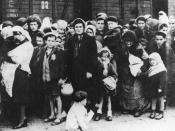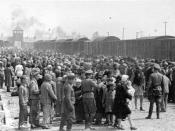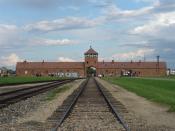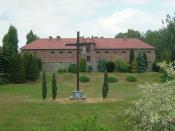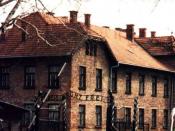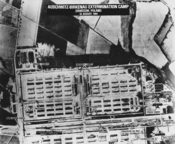Auschwitz Auschwitz was the largest concentration camp and extermination camp of the German Nazi's during the period of the Holocaust. This camp was located near the industrial town of Oswiecim in southern Poland, this was actually three camps in one. It was a prison camp, an extermination camp, and a slave-labor camp. As the most lethal of the Nazi extermination camps, Auschwitz become the main site of the "final solution,"ÃÂ or the Holocaust.
Auschwitz played such an important role mainly because of its location, lying at a railway junction with 44 parallel tracks. These tracks were used to transport Jews from throughout Europe to their death making Auschwitz an easily accessible camp.
When Auschwitz was first created it was started off as small camp for political prisoners as Auschwitz I, and later became a concentration and extermination camp as Auschwitz II with about 300 barracks. The final step to Auschwitz was the slave labor camp that was developed shortly after to be called, Auschwitz III.
Of the different parts of Auschwitz the death camp and slave-labor camps were closely interrelated. Newly arrived prisoners at the death camp were divided in a process known as Selection. The young and the able-bodied were sent to work, while the young children along with there mothers and the old people unable to work were sent directly to the gas chambers. Besides the cruelty of being sent directly to the gas chambers some of the prisoners were chosen for medical experiments. Auschwitz doctors tested methods of sterilization on the prisoners using massive amounts of radiation, uterine injections, and other barbaric procedures. All of these experiments were meant to lead to the fast development on the "Aryan Race,"ÃÂ the perfect and dominant race that the Nazi's planned to create.
Through the period of being an extermination camp between 1.1 and 1.5 million people were killed. Of these slaughtered around 90 percent were Jewish. Added to them are the Poles which were the second largest victim group, with nearly 83,000 that were killed by the Nazi"ÃÂs or died from the harsh conditions that they faced. The only other race which was held at this camp was the gypsies that accounted for approximately 19,000 deaths.
As these tragic events unfolded more and more with every passing day resistance began to emerge. Eventually, plans of the Auschwitz camp were brought out by escaped prisoners; and there was a desire to plan bombings.
Although the industrial complex adjacent to Auschwitz was bombed, the death camp and its crematoria were left untouched, a subject of controversy for many years.
Finally, approaching the end of the Holocaust in 1945 Auschwitz was gradually abandoned and partly destroyed. Although the Germans intended to destroy Auschwitz much of Auschwitz I and Auschwitz II still remained intact and were later converted into a museum and memorial. In 1996, the Polish government joined with other organizations in a large-scale effort to ensure the preservation of Auschwitz and there goals were met as the camps were designated an UNESCO World Heritage site in 1979.
